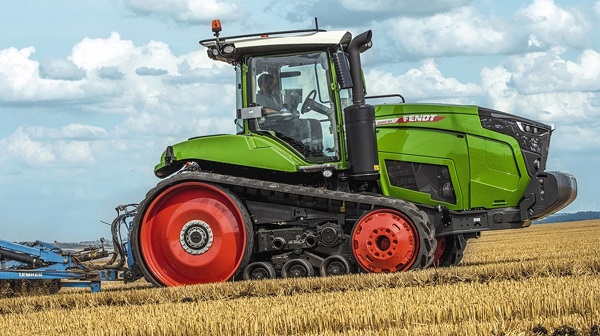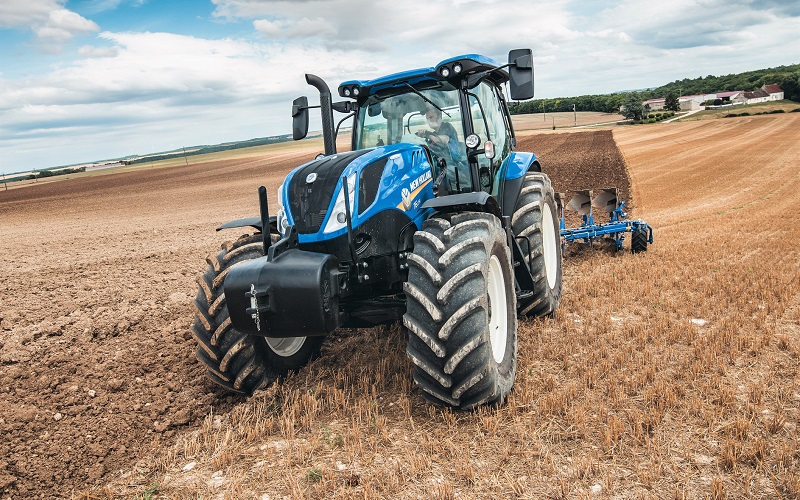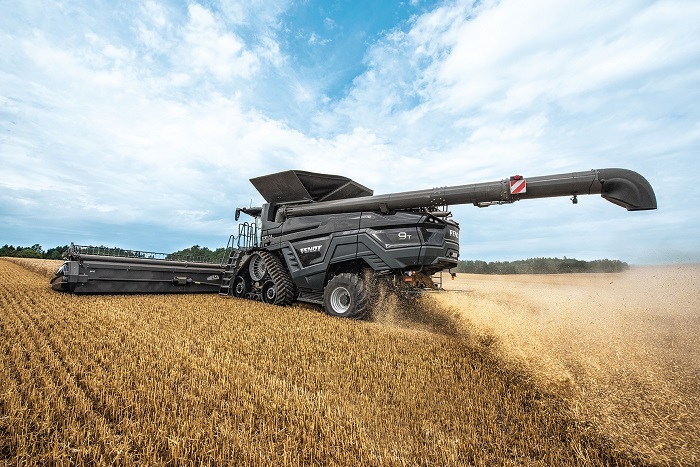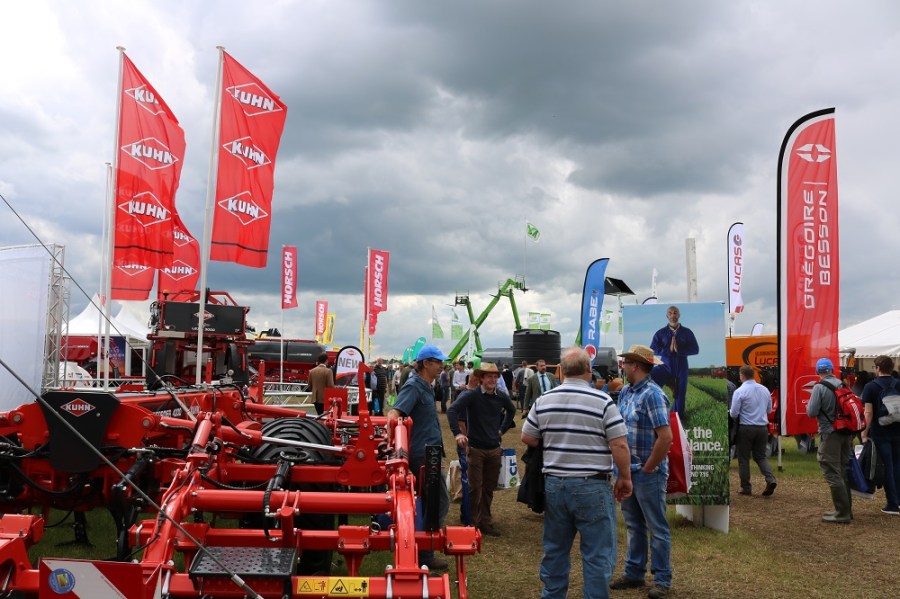There may be fewer exhibitors than last year, but the machinery lines at the UK’s largest arable event are set to impress. CPM rounds up the highlights.
The three-model line features internals that represent a significant departure for the manufacturer’s European combine design.
By Martin Rickatson
[table id=6 /]Seven months after Agritechnica, Cereals 2018 provides the first opportunity for many to get up close to the glittering array of new product launches, tweaks and technological introductions manufacturers have brought on.
The line-up of exhibitors may be reduced, but organisers argue the event remains the showcase for the UK arable industry, and from what they’re promising to present, there’s little doubt those manufacturers who’ll be there on the day will step up to the mark.
Tractors
Although it made its UK debut at LAMMA, the new 900 Vario MT tracked tractor range from AGCO’s Fendt division is likely to be among the biggest crowd-pullers at Cereals. While the larger 1100 MT models are, for now, simply reliveried versions of existing machines, the 900 Vario MT tractors are an all-new blend of Challenger tracklayer design and Fendt wheeled tractor technology, with models of 380, 405 and 431hp. A new cab is the most visible change over the former Challenger MT700 models, while operationally the biggest upgrade is the Vario continuously-variable transmission. Operator comfort improvements include SmartRide primary suspension and ConstantGrip track suspension, plus two-point cab suspension.

Fendt 900 Vario MT tractors are an all-new blend of the brand’s wheeled tractor technology and Challenger tracklayer design.
New Holland is likely to use Cereals to expand on the launch earlier this year of an Auto Command CVT transmission option for certain models in its T9 articulated flagship tractor range. The transmission will be available as an alternative to the standard UltraCommand powershift on the 429-605hp models in the range, the T9.645 and T9.700 remaining powershift-only. Further down the power scale, it’ll show the DynamicCommand eight-step semi-powershift for 145-157hp (max) T6 tractors, introduced as an alternative to the existing four-step powershift and CVT transmissions.

New Holland transmission news includes DynamicCommand eight-step semi-powershift for T6 tractors and AutoCommand CVT for T9 models.
Combines
With stats claimed to include the biggest grain tank on the market, (17,100 litres), the fastest unloading rate (210 litres/sec), and the largest threshing area, calculated as 31% bigger than anything else currently available, Fendt is expected to reveal its version of AGCO’s Ideal combine range at Cereals 2018.
The three-model line features internals that represent a significant departure for the manufacturer’s European combine design, with no drum and concave up front. Instead, a beater/feed rotor transfers material straight to the leading impeller element of 4.8m-long rotors – one on the smallest machine; two on the two larger models. Each 600mm-diameter reversible rotor then features a series of rasp bar sections for threshing, followed by ‘Dual Helix’ fingers for separation. AGCO says there are only 13 belts on the machines.

The three-model Fendt Ideal combine line features 4.8m-long rotors – one on the smallest machine, two on the two larger models.
Beneath the front of the threshing unit a pair of longitudinal grain pans split the crop for even loading. Airflow is supplied by a patented ‘Ciclone’ cleaning system. Cutterbar options include either standard or Powerflow versions in widths up to 12.2m, and there’s an ‘AutoDock’ in-cab coupling system claimed to automatically engage all mechanical, hydraulic and electrical connections in only five seconds. The combine automatically recognises the header and retrieves from the in-cab terminal the last header settings used.
Sprayers
Launched last year, the Vantage Dark trailed sprayer will form the centrepiece of Berthoud’s Cereals stand, with a focus on the various technologies introduced on the machine. These include Spraytronic pulse application, which uses a solenoid valve on each nozzle to vary nozzle flow by up to 70% and thus maintain spray quality without changing spray pressure and regardless of forward speed. Operating options for Vantage Dark include Berthoud’s EC Tronic controller or VT Tronic touchscreen, or ISO Tronic ISOBUS control.
Kuhn hopes to show at Cereals an example from the four new models added to its Oceanis trailed sprayer range, with 5000-7700-litre capacities and 24-48m aluminium booms. Fully ISOBUS-compatible, the machines can be controlled from a single in-cab tractor terminal or Kuhn’s CCI1200 or CCI50 controllers. All are available with Kuhn’s MultiSpray system with electrically-operated nozzle holders, plus a new Easyflow closed transfer induction bowl and the StopMix system, which automatically switches off tank agitation to prevent excessive foam creation. An e-SET cleaning system automates tank rinsing after spraying.
Lemken exhibits will include a Vega 12 trailed sprayer and a Sirius 12 mounted machine, each with the RA rear-folding boom. The 3/4/5000-litre Vega 12, with boom widths of 15-30m, offers possible track widths from 1.50-2.25 m. Steering and suspension are optional, with the axle available in rigid or suspended (mechanical or air) versions. The Vega 12 is the top-specification model in a range that also includes Vega 8 and Vega 10 variants, and is only available as an ISOBUS version. The machine on display will be shown with Lemken’s latest top specification CCI1200 operating terminal, but any other AEF-certified universal terminal can also be used for ISOBUS control.
Also ISOBUS-controlled, the 900-1900-litre/15-30m Sirius 12 is attached via Lemken’s close-coupling QuickConnect top link system. As on the Vega 12, a new MegaSpray operating concept is said to simplify sprayer control via an intuitive menu design. For buyers requiring a separate controller, the same ISOBUS terminal options, including the CCI 1200, are available.
Although not its first time at the event, John Deere’s R4050i self-propelled sprayer, featuring the new PowrSpray solution system and a 5000-litre capacity tank will make its Sprays and Sprayers ring debut, fitted for the first time with a carbon fibre boom. It joins the existing 4000-litre R4040i, and uses the same Deere 235hp engine. But the 18/36m boom is claimed to improve the new machine’s weight distribution, removing around 800kg from the its rear. The material is said to be five times stronger and five times lighter than steel, and its flexibility is reckoned to relieve the structure from the stress loading caused when working at high speeds, as well as benefiting boom ride, reducing inertia and so minimising roll and yaw. Automatic boom levelling is also said to work with greater precision, allowing lower boom heights and higher speeds.
A new, purpose-designed designed waterproof keypad and digital display at the sprayer’s operator station control automated filling, spraying and agitation. The PowrSpray solution system features Deere’s dual-circuit design with two solution pumps. There are two new boom control systems, with TerrainControl Pro providing automatic control of boom height and level, while TerrainCommand Pro includes additional automatic control of the individual boom wings. Both systems feature a new type of ultrasonic sensor, Active Roll Control, and proportional hydraulic valves for faster and more precise boom adjustment.
AGCO’s European-market sprayers are now sold under the Fendt brand, and the green-and-red liveried RG300 trailed and RG600 self-propelled machines will make their Cereals debut. Production has moved from AGCO’s Grubbenvorst, Holland facility to its German Hohenmölsen site, where manufacturing takes place alongside the Fendt Katana forage harvester.
While the colours change, the designs remain unaltered. The 24-36m Rogator 635, 645 and 655 self-propelled models have rated power outputs of 170, 208 and 227hp. Nominal tank capacity options on all machines are 3850, 5000 or, on the largest model, 6000 litres. A rotary pump provides 785 l/min of capacity. There are four Rogator 300 trailed models, from 3300-6600 litres nominal capacity and with 24-30m boom widths. All feature rotary pumps of up to 785 l/min capacity and have 60-litre induction hoppers with up to 200 l/min intake.
Amazone’s new UX 01 4200/5200/6200-litre trailed sprayers feature a new 28° steering axle, complemented by AutoTrail automatic hillside compensation s and load-sensing anti-lock brakes as part of an air-braking package. Control is via a new illuminated operator station with touchscreen, and filling is by way of a new 60-litre induction bowl with 200 litre/min suction. Unfolding of the 27-40m booms is 40% faster than on current models, using a new Flex-fold system with potentiometers controlling the fold-out sequence. There’s also a new ultrasound ContourControl boom height/guidance system and a new SwingStop system to limit boom movement.
Having revealed new self-propelled sprayer developments earlier this year, Agrifac should also have something new to see at Cereals, potentially including the updated Condor Endurance II self-propelled sprayers. Details of new features including the SmartDosePlus injection system and StrictSprayPlus application regulation system should be available.
Cultivation equipment
Making its Cereals debut following an Agritechnica 2017 launch will be a 6m model from Horsch’s new 5-12m Cruiser XL shallow cultivator range, featuring four rows of sprung tines and a rear roller. Also planned for show is a new model of the Terrano GX three- or four-row tine cultivator.
Väderstad plans to show one of its Carrier compact disc cultivators with new CrossCutter disc option. Designed to improve trash/soil mixing at shallow depths of 2-3cm on stubbles, cover crops and on ploughed land, it can be worked at up to 20km/h but has a low horsepower requirement, claims the firm. Available on all Carrier models (3.0-12.25m), the new 450mm discs are individually mounted to rubber suspended disc arms for accurate ground contour following. In addition to cereal stubbles, where it can be used for intensive shallow cultivation to help grassweed control, Väderstad says the CrossCutter disc option is ideal for incorporating cover crops.
New Holland looks set to use Cereals to show examples from its new cultivation equipment lines, which result from parent firm CNH Industrial’s acquisition of Kongskilde’s agricultural implement business. Products so far added to the New Holland line include stubble and seedbed cultivators, power harrows and rotavators, and semi and fully-mounted reversible ploughs from three to eight furrows in both fixed and variable-width formats.
First shown at Agritechnica 2017, Kuhn’s new Vari-Master L on-land plough should make an appearance on the firm’s stand. It features a new offset kinematics design for improved ‘pull’ and resulting fuel and wearing-metal savings. Further features include a patented adjustment system for skimmer angle for improved residue burial, and a new arched beam designed to reduce wheel overhang and thus minimise unworked land.
Amazone’s new Ceus combination cultivators combine a double row of Catros 510mm serrated discs at 250mm spacing followed by C-Mix tines from the Cenius mulch cultivators, arranged in a multi-row stagger and spaced at 40cm. Point choices range from 320mm goose foot stubble shares to 40mm deep work tines. A row of levelling double discs and a full-width following roller follow up. Tines are either mechanically or hydraulically depth-adjustable, and can be lifted out of work completely. Ten different following roller options are available; the machine at Cereals will be equipped with the new DDW double disc roller.
Drills
Among the Väderstad exhibits at Cereals 2018 will be an 18-row Tempo L precision drill. With units set at 500mm spacing, the company is promoting the machine’s capabilities beyond the likes of maize and suggests it has potential for establishing sugar beet and even oilseed rape. For crops such as maize or sunflowers, the drill can work at 12 rows, with spacing at 700-800mm.
Lemken drill exhibits will include the firm’s entry into the precision drill market, the Azurit 9. Available in 4, 6 or 8-row formats, and with 50cm or 75cm row spacings, it can be combined with a front tank as well as with the firm’s Solitair 25 – with which it will be shown at Cereals – and Compact-Solitair drills. The Azurit features Lemken’s DeltaRow planting technology, placing seed in staggered twin sub-rows spaced 12.5cm apart. This is claimed to provide each plant with 70% more surface area than conventional single-row placement, benefiting root growth, water and nutrient uptake, and sunlight interception.
Amazone’s 12m and 15m Citan C drills now feature a new 8000-litre three-section pressurised seed hopper, enabling simultaneous sowing of up to three different materials. A new step and platform improve hopper access, and controls are now grouped in a new operator station at the front left corner of the drill. Citan drills now adopt the RoTeC pro S single disc coulters from the Cirrus with their 400mm diameter boron steel discs. Also on show will be the new Centaya power-harrow drill combination.
On the Horsch stand, which will include a working plot, visitors will be able to see two new low-disturbance drills. The new 10/12m Serto SC features an all-over tyre packer combined with a heavy double-disc seed coulter, with two coulters behind each tyre, spaced at 16.6cm. Meanwhile, a new 6m model joins the existing 8m and 9m Pronto NT models, using the same fluted discs to till the seed rows. KRM also hopes to unveil drill developments, but further details were unconfirmed as CPM went to press.
Opico plans to unveil at Cereals the updated Maxi Drill 10 min-till drill launched at Agritechnica 2017. New features include the ability to apply three different products from separate hoppers with individual metering systems, feeding into two distribution circuits and placing product at two different depths. The third can be introduced to either distribution circuit and sown at the same depth as the first or second product. The three hoppers each have their own electronic metering units and are operated by a single control unit in the tractor´s cab. There are also redesigned coulters for improved residue penetration, and redesigned cultivation discs, with maintenance-free sealed hubs and rubber shock absorbers.




